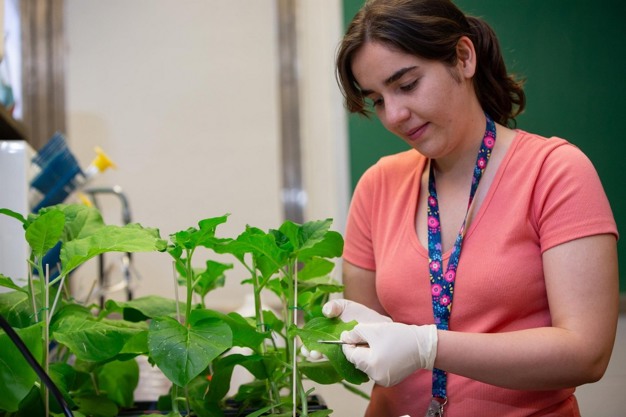Chemists at the University of Cincinnati are working on a simple way to diagnose viruses in plants before they infect entire crops. It might be odd to think of a plant catching a cold, but viruses are a major problem in agriculture. Crop diseases cause more than $21 billion in losses each year in the United States.
Students in UC Assistant Professor Pietro Strobbia's chemistry lab are examining efficient and accurate methods to detect plant viruses before they even show symptoms such as spotting or yellowing of leaves.
UC researchers working with the University of Kentucky developed hydrogel sensors that detect pathogens through contact with the leaf. Researchers abraid the leaf and apply a hydrogel sensor, which uses spectroscopy to "fingerprint" the chemicals found in the sample.
Any virus present has nowhere to hide, Strobbia said.
 Photo/Andrew Higley/UC Marketing + Brand
Photo/Andrew Higley/UC Marketing + Brand
He and his students are refining the process now to use microneedles instead of the hydrogel for a simpler, easier test.
In Strobbia's lab, students are studying tobacco mosaic virus, which infects hundreds of different plant species. It spreads through direct contact with other plants as well as spreading by insects and agricultural workers. It is named for the mosaic pattern of light and dark colors on infected leaves. It also causes spotting and stunting of infected plants. There is no cure for tobacco mosaic virus so the only solution is to destroy infected plants.
And the virus can persist in dried sap where it can be spread to other plants by incidental contact, according to the Penn State Extension.
Strobbia said quick detection could prevent the spread of the disease across an entire crop.
Identifying the virus often requires complicated molecular tests or visual inspection of diseased plants, which isn't always accurate.
"The diagnosis of plant infection relies on visual cues," said Lyndsay Kissell, a UC visiting scholar who worked as a postdoctoral researcher in Strobbia's lab. "That means the plants are already sick enough to show symptoms.
"If we can diagnose these infections sooner, then farmers would be able to isolate infected plants and remove them before infection spreads throughout a field," she said.
UC doctoral student Manisha Sheokand said the sensors they developed are inexpensive, accurate and easy to use.
"This approach is aimed to be field-deployable, cost-effective, reliable and allow real-time detection of plant viruses," she said.
Scholar Kissell said the challenge is identifying the virus at the low concentrations required for early detection.
"Because we wanted to detect these infections early, we had to be able to sense even when the viral load was low. By using a hydrogel matrix, we were able to overcome both of those challenges," she said.
Early detection could make a big difference for growers and their yields, she said.
"I grew up around farming communities and know what a poor yield year can mean. With early diagnosis, perhaps we can lessen that impact," she said.
